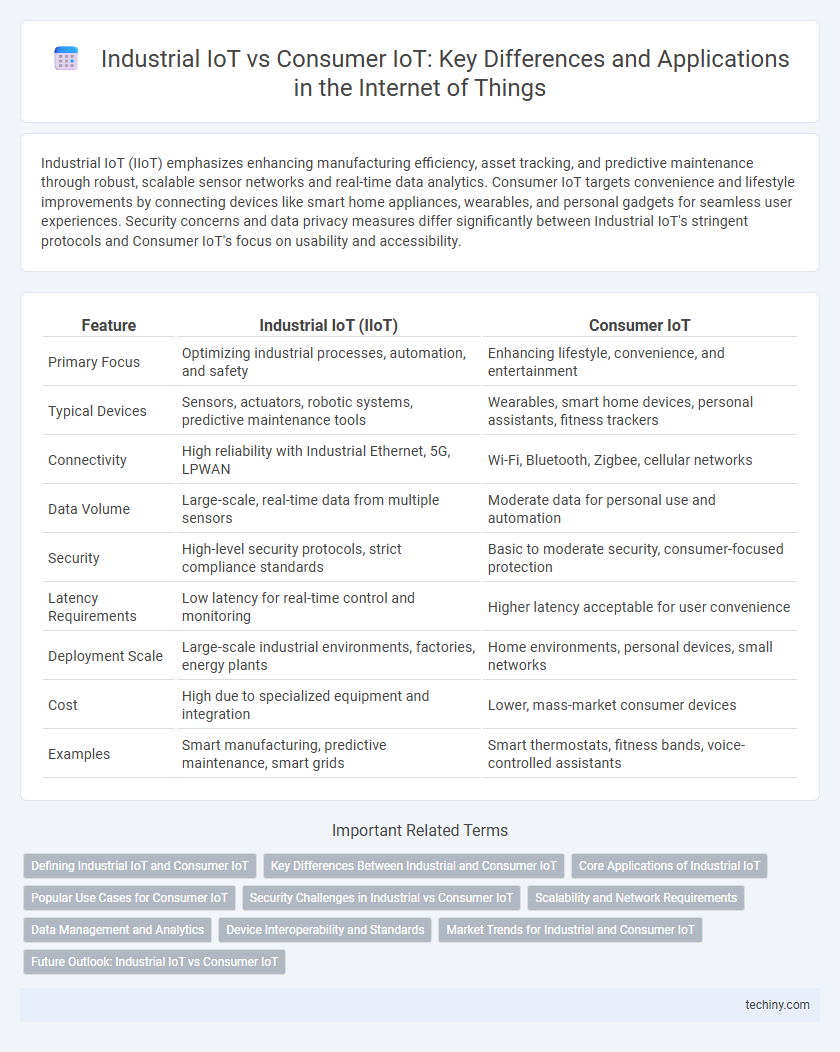Industrial IoT (IIoT) emphasizes enhancing manufacturing efficiency, asset tracking, and predictive maintenance through robust, scalable sensor networks and real-time data analytics. Consumer IoT targets convenience and lifestyle improvements by connecting devices like smart home appliances, wearables, and personal gadgets for seamless user experiences. Security concerns and data privacy measures differ significantly between Industrial IoT's stringent protocols and Consumer IoT's focus on usability and accessibility.
Table of Comparison
| Feature | Industrial IoT (IIoT) | Consumer IoT |
|---|---|---|
| Primary Focus | Optimizing industrial processes, automation, and safety | Enhancing lifestyle, convenience, and entertainment |
| Typical Devices | Sensors, actuators, robotic systems, predictive maintenance tools | Wearables, smart home devices, personal assistants, fitness trackers |
| Connectivity | High reliability with Industrial Ethernet, 5G, LPWAN | Wi-Fi, Bluetooth, Zigbee, cellular networks |
| Data Volume | Large-scale, real-time data from multiple sensors | Moderate data for personal use and automation |
| Security | High-level security protocols, strict compliance standards | Basic to moderate security, consumer-focused protection |
| Latency Requirements | Low latency for real-time control and monitoring | Higher latency acceptable for user convenience |
| Deployment Scale | Large-scale industrial environments, factories, energy plants | Home environments, personal devices, small networks |
| Cost | High due to specialized equipment and integration | Lower, mass-market consumer devices |
| Examples | Smart manufacturing, predictive maintenance, smart grids | Smart thermostats, fitness bands, voice-controlled assistants |
Defining Industrial IoT and Consumer IoT
Industrial IoT (IIoT) refers to the integration of interconnected sensors, instruments, and devices in manufacturing and industrial processes to optimize operations, enhance productivity, and improve safety. Consumer IoT involves smart, internet-connected devices used in everyday life, such as wearable technology, smart home systems, and personal health monitors. While IIoT focuses on large-scale industrial applications, Consumer IoT prioritizes convenience and automation for individual users.
Key Differences Between Industrial and Consumer IoT
Industrial IoT (IIoT) emphasizes robust, scalable systems designed for manufacturing, energy, and supply chain management with priorities on security, real-time analytics, and operational efficiency. Consumer IoT focuses on user-friendly devices such as smart home gadgets and wearable technology, prioritizing convenience, connectivity, and ease of integration with personal devices. The key differences lie in application complexity, reliability requirements, and data processing capabilities tailored to industrial environments versus consumer usage.
Core Applications of Industrial IoT
Industrial IoT (IIoT) primarily focuses on optimizing manufacturing processes, predictive maintenance, and asset tracking to enhance operational efficiency and reduce downtime. Core applications include smart factories leveraging real-time data analytics, remote monitoring of machinery to prevent failures, and supply chain automation for seamless inventory management. These applications harness interconnected sensors and advanced analytics to drive productivity and safety in industrial environments.
Popular Use Cases for Consumer IoT
Consumer IoT primarily includes smart home devices such as voice-activated assistants, security cameras, and smart thermostats that enhance convenience, security, and energy efficiency. Wearable technology, like fitness trackers and smartwatches, monitors health metrics and supports personalized wellness. These use cases highlight the growing trend of interconnected personal devices aimed at improving daily life.
Security Challenges in Industrial vs Consumer IoT
Industrial IoT (IIoT) faces more complex security challenges than Consumer IoT due to its integration with critical infrastructure and operational technology, increasing the risk of cyber-physical attacks. IIoT environments require robust, multi-layered security protocols to protect sensitive industrial control systems (ICS) and ensure operational continuity, while Consumer IoT devices often prioritize convenience over stringent security measures. The scale and impact of breaches in IIoT networks can lead to significant financial losses and safety hazards, highlighting the need for advanced threat detection and response strategies distinct from those in consumer applications.
Scalability and Network Requirements
Industrial IoT demands high scalability and robust network infrastructure to support thousands of devices with real-time data processing and low-latency communication, often utilizing private or hybrid networks. Consumer IoT typically operates on public networks with moderate scalability needs, emphasizing ease of integration and energy efficiency over extensive device deployment. Industrial environments prioritize reliability, security, and bandwidth to manage critical operations, whereas consumer applications focus on usability and cost-effectiveness.
Data Management and Analytics
Industrial IoT (IIoT) emphasizes advanced data management and analytics for real-time monitoring, predictive maintenance, and operational efficiency, leveraging large-scale sensor networks and edge computing. Consumer IoT prioritizes user-friendly data collection and cloud-based analytics for personalized experiences, device interoperability, and home automation insights. Robust data security and scalable analytics platforms are critical across both sectors to handle vast data volumes and derive actionable intelligence.
Device Interoperability and Standards
Industrial IoT prioritizes robust device interoperability through strict adherence to standardized protocols like OPC UA and MQTT, ensuring seamless communication across complex manufacturing systems. Consumer IoT, however, often struggles with fragmented standards, leading to compatibility issues among devices from different brands. Emphasizing universal standards such as Zigbee and Thread in both sectors can significantly enhance cross-device communication and integration.
Market Trends for Industrial and Consumer IoT
The Industrial IoT market is projected to reach $263 billion by 2027, driven by manufacturing automation, predictive maintenance, and smart factory implementations. Consumer IoT, valued at approximately $150 billion in 2023, grows rapidly due to smart home devices, wearable technology, and personal health monitoring systems. Market trends reveal industrial applications emphasize security and scalability, while consumer IoT prioritizes user convenience and interoperability across diverse ecosystems.
Future Outlook: Industrial IoT vs Consumer IoT
Industrial IoT (IIoT) is projected to drive significant advancements in manufacturing automation, predictive maintenance, and supply chain optimization, fueling efficiency and cost savings in sectors like energy, automotive, and aerospace. Consumer IoT is expected to expand through smart home devices, wearable technology, and connected healthcare, enhancing convenience and personal well-being with increased adoption of AI-driven personalization. Market forecasts indicate IIoT will grow with higher investment in cybersecurity and edge computing, while Consumer IoT growth hinges on interoperability and user data privacy improvements.
Industrial IoT vs Consumer IoT Infographic

 techiny.com
techiny.com